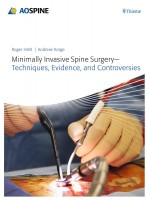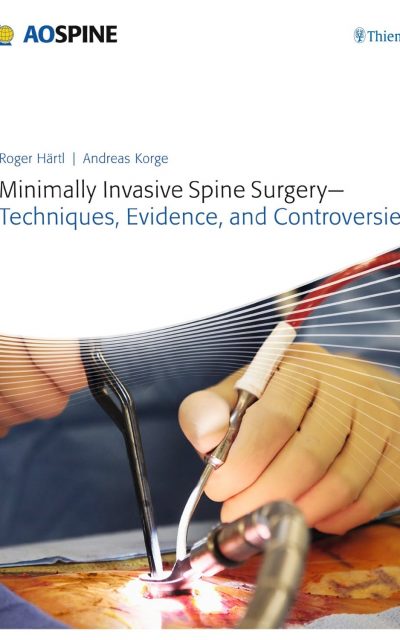 Editors: Roger Hartl and Andreas Korge
Editors: Roger Hartl and Andreas Korge
Publisher: Thieme – 490 pages (711 images)
Book Review by: Nano Khilnani
This book is one of the most accessible, advanced, and comprehensive ones in its field, offering 700+ images, 35 cases (with actual photos), research findings, surgical techniques (and discussions of their pros and cons), tips and tricks obtained through experience, and much else highly useful. It is also very user-friendly, and really designed to teach you – the student or practitioner interested in minimally invasive spine surgery (MISS) – something that is growing in popularity and use.
Seventy-six specialists from the United States and Austria, Brazil, Germany, India, Switzerland, Thailand, and the United Kingdom authored the chapters and contributed other material for this rare book that presents and discusses in detail, minimally-invasive methods used in surgery on various parts of the human spine.
These specialists have a vast amount of collective experience and expertise in the fields of: head and neck surgery, neurology and neurosurgery, orthopedics and orthopedic surgery, otolaryngology, pain therapy, scoliosis, spine surgery, traumatology, and other areas.
This book of nearly 500 pages – and more than 700 different images of several types – is simply organized into five Parts, namely:
- Fundamentals
- Cervical techniques
- Thoracic techniques
- Lumbar / sacral techniques
- Critical overview and outlook
The images consist of actual photos of anatomical parts, patients and operating room setups before and during surgery; accurate, detailed full-color drawings of parts of the spine; computed tomography (CT) scans of bones and other internal parts; images through microscopes showing abnormalities, diseases and disorders; magnetic resonance images (MRIs) of various conditions; and x-rays (preoperative and postoperative) showing problems and solutions.
Drs. Hartl and Korge point out that minimally invasive spine surgery in one form or another has origins dating back more than a hundred years, with varying degrees of success and results. But technological advances have enabled surgeons to effectively provide relief to spine patients and save their lives.
Among other benefits, minimally invasive spine surgery has helped patients to:
- Reduce muscle damage
- Minimize blood loss
- Provide relief from postoperative pain.
But for patients to benefit from these desirable outcomes, even highly-skilled surgeons ”must prepare themselves for a demanding learning curve,” the authors emphasize.
The wealth of information provided in this valuable book can perform a critical role for you in obtaining that learning, even as we realize that repeated surgical practice is a must in developing the needed skills.
The editors and authors end with several broad conclusions:
- Minimally invasive spine surgery is here to stay, as a logical consequence of the evolution of surgery
- This type of surgery offers alternative and frequently advantageous treatment options in all regions of the spine
- More work is needed, especially in the area of spinal deformity correction, which will depend on integration of scientific progress, technical expertise, and the surgeon’s individual experience and good judgment
- Surgeons have to be willing to learn and evolve, and to continue to critically and honestly evaluate the pros and cons of this type of surgery and their own results with patients.
This book is a pioneering effort in a new and growing area of spine surgery and its editors and authors, named below, are truly trail blazers!
Editors:
Roger Hartl, MD is the Leonard and Fleur Harlan Clinical Scholar in Neurological Surgery, Associate Professor of Neurological Surgery, and Director of Spinal Surgery in the Department of Neurological Surgery at the Weill Cornell Brain and Spine Center in New York, New York.
Andres Korge, MD is Head of Department, Spine Center at Schon Klinik Munchen Harlaching in Munchen, Germany.
Authors:
Beejal Y. Amin, MD
Neel Anand, MD
Vijay Anand, MD, FACS
Ali A. Baaj, MD
Gopalakrishnan Balamurali, FRCS Neuro
Eli M. Baron, MD
Rahul Basho, MD
Rudolf W. Beisse, Prof Dr.
Oheneba Boachie-Adjei, MD
Bronek Boszczyk, PD Dr. med
Salvador A. Brau, MD, FACS
Dean Chou, MD
Michelle J. Clarke, MD
Mark B, Dekutoski, MD
Eric H. Elowitz, MD
Richard G. Fessler, MD, PhD
Daniel Gelb, MD
Alex Gitelman, MD
Patrick Hahn, Dr med
Roger Hartl, MD
Franziska C. Heider, MD
Paul F. Heini, Prof Dr med
Paul S. Issack, MS, MD, PhD
Andrew James, Dr
Sheila Kahwaty, Physician Assistant – Certified
Iaian H. Kalfas, MD
Frank Kandziora, MD, PhD
Rishi Mugesh Kanna, MS, MRCS, FNB
Manish K. Kasliwal, MBBS, MCh
Babak, Khamsi, MD
Mark Kleinschmidt, Dr med
Martin Komp, Dr med
Andreas Korge, MD
Kuansongtham Verapan, MD
Khai Lam, MD
Rondall K. Lane, MD, MPH
Jeremy Lieberman, MD
Steven C. Ludwig, MD
H. Michael Mayer, MD, PhD
John McCormick, MD
Paul C. McCormick, MD, MPH, FAANS
Christoph Mehren, MD
Osmar JS Moraes, MD
Yaron A. Moshel, MD, PhD
Praveen V. Mummaneni, MD
Eric W. Nottmeier, MD
Alfred T. Ogden, MD
Sylvain Palmer, MD, FACS
Luca Pupavero, Prof Dr med
Sampoch Paiboonsirijit, MD
Noel I. Perin, MD, FRCS (Ed)
Mark Pichelmann, MD
Luiz Pimenta, MD
Shanmuganathan Rajasekaran, Dr, PhD
Marcus Richter, MD
Daniel Riew, MD
Sebastain Ruetten, Priv-Doz, Dr, med habil, MD
Rajiv Saigal, MD, PhD
Walter Saringer, Prof Dr med
Philipp Schleicher, Dr
Meic H. Schmidt, MD, FACS
Theodore Schwartz, MD, FACS
Christopher I Shaffrey, MD, FACS
Ajoy Prasad Shetty, MS DNB Ortho
Patrick Shih, MD
Nicholas Slimack, MD
Volker Sonntag, MD
John Stark, MD
Lukasz Terenowski, MD
William D. Tobler, MD
Juan S. Uribe, MD
Jeffrey C. Wang, MD
Michael Y. Wang, MD, FACS
Jean-Paul Wolinksy, MD
James Zucherman, MD







